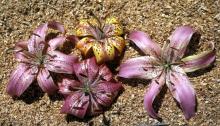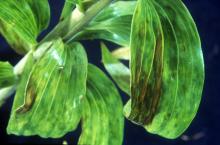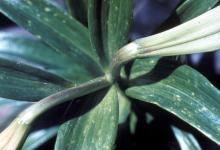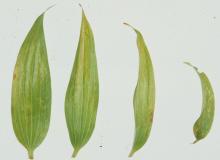Cause There are more than 11 viruses that can be a problem on lily. Lily symptomless virus (LSV), lily mottle virus (LMV), cucumber mosaic virus (CMV), and tulip breaking virus (streak disease) are common problems. Aphid vectors are effective carriers of each of these viruses and CMV can also be mechanically transmitted. Fleck can occur when both LSV and CMV are in the lily at the same time.
Symptoms LSV-mild mottle, severe mottle, basal striping, and twisting can occur on leaves. Disease symptoms vary with lily cultivar, clone, and environment. Plants are shorter and take longer to flower when concentrations of the virus are higher.
LMV - Vein clearing, leaf mottle, leaf mosaic, chlorotic and yellow streaking, leaf curling and narrowing have all been associated with this virus. Some cultivars show flower color break.
CMV - Light-green mosaic that often evolves to a gray or brownish necrotic spot. Leaves become brittle and flowers are malformed.
Fleck-white or yellowish fleck spots become apparent in affected plants' leaves. Spots are barely noticeable in the youngest leaves but conspicuous in older ones. As the disease progresses, the leaves tend to twist; plants are stunted and, if they bloom, produce flowers that are worthless.
Streak-typical streak plants are stunted, darker than normal green, and conspicuously streaked with white fleck spots that may extend several inches along the veins. Streak differs from typical fleck in that the fleck spots form long streaks, and affected plants usually die within a year.
Cultural control
- Plant only the healthiest scales available. Stock that has been tested and found free of all known viruses is most desirable. Lily seed is virus-free.
- When plants are in the asparagus stage, about 4 inches tall, and when leaves first fold out, examine them for mosaic viruses. Fleck diseases are unlikely to be noticed until plants are older.
- Rogue out and destroy affected plants.
- Disinfect cutting knives and other tools frequently by soaking 60 sec in 10% bleach (Clorox), or shellac thinner (70% ethyl alcohol), or quaternary ammonium (Physan 20).
- If breeding lilies or if growing seedlings to escape viruses, cage or otherwise protect seedlings from aphids. One winged aphid can infect several plants with certain viruses. Unfortunately, most virus diseases are undetectable in lily seedlings before the second or third season of growth, which makes protecting the seedlings imperative.
Chemical control Weekly applications of mineral oil have shown some efficacy against a few of the non-persistent viruses but have the potential to decrease bulb weight. Additions of some insecticides with the oil have helped reduce oil rates. See the PNW Insect Management Handbook for details.
References Asjes, C. J., and Blom-Barnhoorn, G. J., 2001. Control of aphid-vectored and thrips-borne virus spread in lily, tulip, iris, and dahlia by sprays of mineral oil, polydimethylsiloxane and pyrethroid insecticide in the field. Annals of applied biology, 139:11-19.
Chastagner, G.A., van Tuyl, J.M., Verbeek, M., Miller, W.B., and Westerdahl, B.B. 2018. Diseases of Lily. In McGovern, R.J. and Elmer, W.H. (eds.) Handbook of Florists' Crops Diseases. Springer Int.







